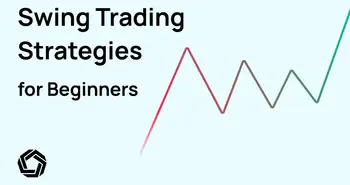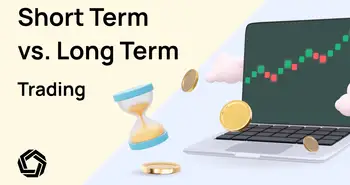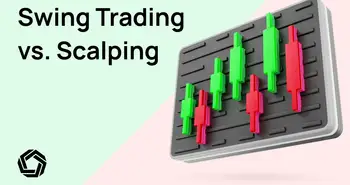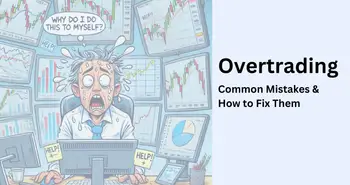Intraday Trading 101: A Beginner’s Guide to Day Trading
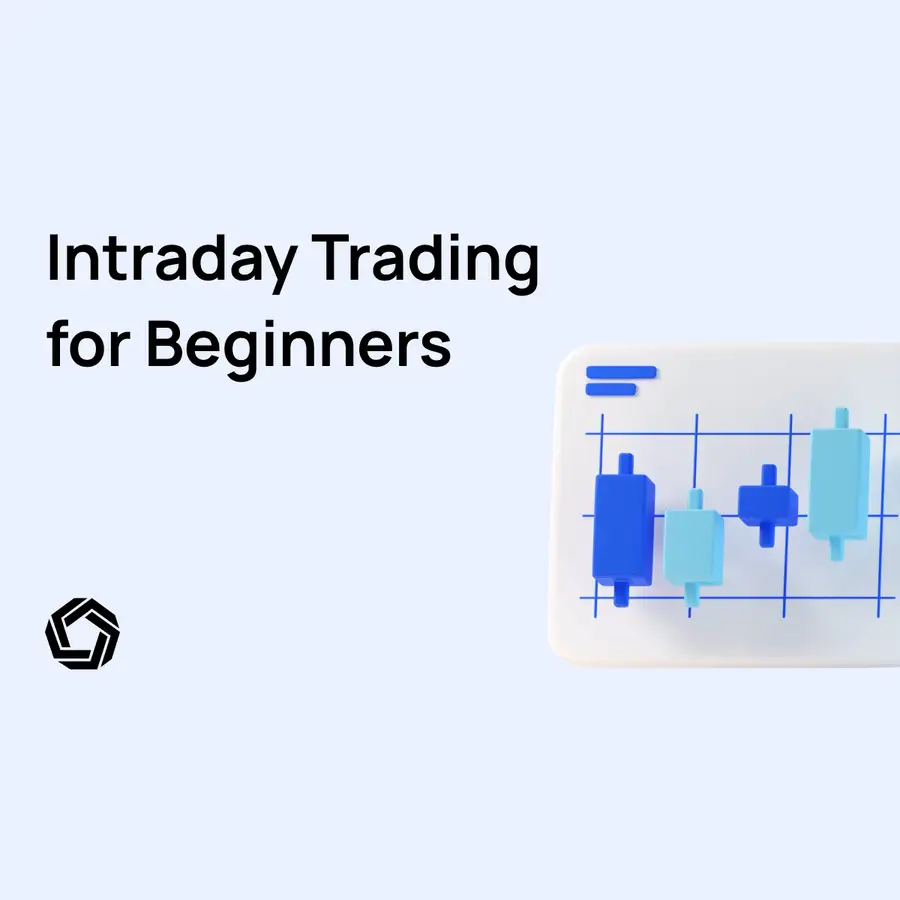
In this article we will cover the basics of intraday trading, including the strategies used by successful traders, how to get started with intraday trading, how to avoid beginner mistakes and the risks involved. By the end of this article, you will have a better understanding of the opportunities and challenges of day trading, and be equipped with the knowledge you need to start your journey as a day trader.
Intraday trading, sometimes referred to as day trading, is the buying and selling of stocks or securities with an emphasis on earning immediate, short-term profits. Day traders try to exploit, either on the upside or the downside, a stock’s volatility. These traders make their profits (or earn their losses) by trying to predict a stock’s short-term up or down price action.
Day traders must take a number of things into consideration in predicting a stock’s daily price action, such as positive or negative company news, market sentiment, and earnings reports.
Intraday trading differs significantly from the overall concept of investing. Investing relates to the basic premise of purchasing stocks having a low price and then holding these stocks for the long term, hoping to eventually sell these stocks at a higher price.
In contrast, intraday buying and selling occurs during one continuous buying cycle, like a single business day. Indeed, intraday traders may be buying or selling stocks during a shorter period of time, like minutes or even seconds. Because day traders exit all of their trades before the daily market closes, they avoid the risk of holding market positions open overnight.
Here is an example:
Assume that a day trader identifies a stock that starts the trading day at a price that the trader considers a historically low price. They purchase 1,000 shares immediately when the market opens at 9 am EST. For the remainder of the day, the trader keeps a watchful eye on the stock’s price movement. Fortunately for the trader, an hour before the markets close at 4 pm EST, the target stock goes up by 1% over what the trader paid that very morning. With an hour left before the markets close, the 1,000 shares are sold, thereby earning the day trader a slight profit.
Intraday Trading Versus Other Types of Trading
Intraday trading should not be confused with other types of trading philosophies, like interday trading, swing trading or scalping.
For example, interday trading involves trading over the course of more than one day. Generally speaking, interday traders take out positions by purchasing shares at some point during trading hours. Interday traders do not necessarily exit their trades before the markets close. Rather, the interday trader will hold their positions until trading resumes the following day.
Intraday trading is also different than swing trading. Whereas intraday trading is focused on a single trading session (one-day session), swing traders hold either a long position or a short position for longer than just one trading session (for more than one day).
Swing traders typically do not hold their positions for longer than several weeks or months. Unlike day traders, swing traders are susceptible to market volatility that may take place between trading sessions, like overnight and weekend risk. Depending on the volatility of the stock price, the stock price could open the following session at a substantially different price.
The inherent volatility of intraday trading presents the intraday trader with a number of potential risks and it might not be too easy to earn 100 dollars a day trading.
For example, one of the primary risks is incorrect stock selection. This relates to the loss that may be incurred due to the trader incorrectly selecting a stock or stocks that do not move in the anticipated pricing direction.
Another challenge associated with day trading is high-risk. As multiple studies have shown, it is very difficult to successfully predict short-term (or even long-term) stock price movements.
Also, traders should be mindful when utilizing margin and/or leverage and gauge their exposure. A trader’s risk is directly proportional to the amount of margin or leverage that the trader is engaged in.
Risk of Excessive Exposure
Leveraging allows traders to take exposures in the market that are much higher than traders can afford to cover. However, taking high exposures comes with the risk of heightened losses. Learn more about the pros and cons of leverage in our article “Leverage Trading: A Double-Edged Sword”.
There are potential upsides to becoming an intraday trader. First, this is a WFH job that can be done in the comfort of your home. However, intraday traders need to be well informed of the potential risks.
Also, intraday trading represents a potential source of income for those who are well-informed, and who also mitigate their exposure. It is all about taking incremental profits through multiple trades throughout the day, rather than seeking a single profit from a single trade.
Intraday traders should make realistic assessments of the inherent market fluctuations and related risks. Some, but not many intraday traders are able to turn their trading strategies into a secondary, and sometimes a primary income source.
Getting Started with Intraday Trading
Persons interested in intraday trading can get started by first selecting a trading platform that supplements their trading strategies or philosophies. You can always read some stock market books for beginners to figure out some strategies. The trading platform should also be selected for certain resources that assist you with pursuing your trading philosophy.
In addition, day traders will be frequently entering and exiting out of multiple daily trades in pursuit of slim margins. To support this approach to investing, day trading platforms need to be cost-effective (that is, charge low commissions) and need to execute trades quickly and reliably.
Moreover, day traders should select a trading platform that offers friendly and informed customer support. Also, traders should opt for trading platforms that provide the type of resources and research that support their type of intraday trading strategies.
Traders can reduce losses by implementing an intraday strategy before they begin trading. By outlining and implementing such a strategy, traders will be able to avoid making emotional decisions. Such decisions made on emotions that are potentially devoid of any basis on the overall trading strategy can lead to adverse consequences, potentially leading to mounting losses.
For example, one tool that can be highly instructive is chart patterns. Chart patterns graphically represent price action over a set period of time for assets such as bonds, stocks, commodities, and cryptocurrencies. When combined with other financial tools, chart patterns provide a great way to predict price movements. For example, candlestick charts are one such chart typically used by intraday traders. These charts are used to depict ways in which price movement is expressed over a period of time.
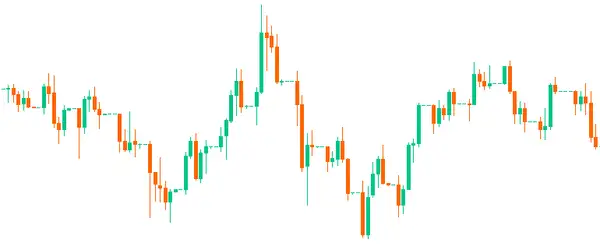
Candlestick charts create a new bar based on the timeframe selected by the trader. If the chart above would be set to daily, then one candle would represent 1 day. Each candlestick shows the open price, low price, high price, and close price of a market for a particular period of time (e.g. D = Daily, 1H = 1 Hour, 15M = 15 Minutes).

Another popular analytical day trading tool is technical analysis. Technical analysis focuses on historical price movements as these price movements are captured by different charts and other visual metrics. Technical analysts utilize technical indicators and charts as they believe that a stock’s historical price movements are potential future price predictors.
Note, however, that technical analysis and fundamental analysis are different. Fundamental analysis is a trading discipline that scrutinizes a stock’s underlying business fundamentals and financial metrics rather than its historical pricing data points.
A common tool used to manage trade upside and/or downsides is the implementation of stop-loss orders. Stop-loss orders are used by traders to limit their potential losses and may also be used to secure their potential gains.
Principally, a stop-loss order is a risk mitigation tool that enables a trader to exit a trade if the price of the underlying stock is trending in a direction that is opposite to that of the trader’s position. The exit trade will be completed at the best available price.
For example, a stop loss order to sell is an order to exit a trade of an underlying stock if the price of that stock resides at or below a targeted stop loss price. Such a situation may arise where the trader has longed the stock and wants to limit the potential loss exposure given that the stock is decreasing in value.
Similarly, a stop loss order to buy is an order to exit a trade of an underlying stock if the price of the stock resides at or above a targeted stop-loss price. Such a situation may arise where the trader has shorted the stock and wants to limit the potential loss exposure given that the stock is increasing in value.
Developing a Successful Day Trading Strategy
Traders often rely on certain core principles in building a successful trading career.
First, most successful traders have a well-developed plan and have laid out underlying strategies for implementing this plan. Traders should remember to build their portfolios based on what they are trying to achieve and their underlying financial strengths.
Second, intraday trading can be as volatile as any other trading strategy. Traders need to manage to control greed and fear once that initial trade is placed. It is not always necessary that traders earn a profit for each and every trade. Intraday trading is fast paced trading but this trading scheme still requires patience and understanding.
And then finally note that daily analysis and research is necessary as the market remains dynamic and is not static. The market’s momentum must be reflected in an evolving trading strategy. An informed intraday trader will update and revise trading methodologies with evolving market trends.
With these core principles in mind, traders have utilized a number of successful intraday trading strategies. These trading strategies include high-frequency trading, scalping, range trading, and news-based trading.
For example, high-frequency trading is an algorithmically based strategy that utilizes complicated algorithms (mathematical formulas) to make a profit based on tiny or short-term market inefficiencies or anomalies.
Scalping is a popular trading strategy amongst intraday traders. It involves a trader making multiple small trades in the same stock throughout a given day. With this trading strategy, traders try to generate an overall profit by way of multiple-minute price fluctuations.
A range trading strategy is where a trader initiates trades within a certain price range where prices vary between a security’s support and resistance levels. Generally speaking, the support and resistance levels are identified on a stock’s price chart wherein the stock price moves frequently between these two levels.
Support (a lower level or floor) and resistance (a higher level or ceiling) are two respective levels on a price chart that appear to limit the market’s range of movement either in the upward direction (resistance level) or in the downward direction (support level). The support level is where the price regularly stops falling and then rebounds. The resistance level is where the price normally stops rising and drops back down.
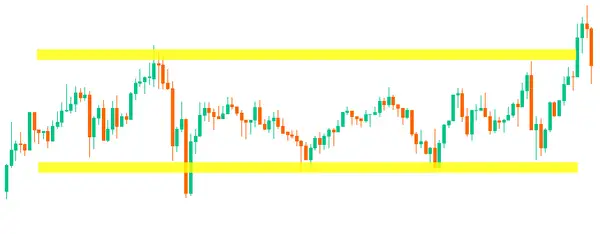
The more often a price hits either the support or resistance level, the more reliable that level is likely to be in predicting future price movements. These levels can also be used to define a trader’s entry and exit points.
Another day trading strategy that is often used is a news-based trading strategy. With this strategy, traders closely follow political, financial, and business-related events and then predict how these events may impact the markets. When a news event starts to affect a stock’s price, a trader will try to capitalize on price changes to generate a profit.
Once a stock or type of stock has been identified, most successful day traders will identify certain entry and exit points to decide when to enter a position (entry point) or to exit their position (exit point).
For example, an entry point refers to the stock price at which a trader initiates a position in a security. This entry position can be initiated with either a buy order for a long position or a sell order for a short position. Similarly, an exit point refers to the stock price at which a trader closes a position in a security. An exit point acts as a stop level. An exit can be initiated with either a sell order for a long position, or a purchase order for a short position.
Advanced Intraday Trading Techniques
There are many different types of advanced intraday trading techniques that traders utilize to increase their potential profits.
For example, day traders will often establish a margin account with their brokerage so that they can trade on margin. A margin account is a brokerage account in which a broker lends a trader cash while using certain deposited account contents as collateral. This arrangement allows traders to purchase assets based on these borrowed and collateralized funds. Typically, margin accounts can be used to purchase different types of financial assets, such as stocks, options, futures, and cryptocurrencies.
With a margin account, traders can use their existing assets as leverage allowing them to borrow up to a certain percent of the value of the security that they are buying. With margin, traders can enhance their potential winnings but can also increase their potential exposure if the stock moves in an undesired direction.
Here is an example. Let’s say a trader wanted to buy $10,000 worth of a particular stock using their own money along with money borrowed from an established margin account. The trader could use $5,000 of their own money to purchase $5,000 worth of shares. Then, they could borrow $5,000 from their margin account to purchase additional shares.
If the stock was worth $100 when purchased and the share price went up to $150, had the trader sold at this price, they would have netted $15,000. From this $15,000, they would have to pay back the $5,000 margin loan leaving them with a $5,000 profit ($10,000 – their original $5,000).
This would represent a 100% gain over the original $5,000 the trader invested with their own money. If they had placed this trade without tapping into the margin account, the net takeaway would only have been $2,500 or only 50%.
On the other hand, if the stock price had tanked to $50 and the trader sold at this price, they would only have netted $5,000. After paying back the $5,000 margin loan, the trader would be left with a negative balance. Essentially, a 100% loss from their original $5,000 investment even though the stock lost only fifty percent of its original value.
Please note that these hypotheticals do not take into account the interest that must be paid for use of the margin loan. Of course, these interest payments would reduce the potential profits and also increase the potential losses for use of the margin account.
The concept of leverage is similar to that of margin. Leverage relates to traders using borrowed funds as an investment vehicle. Traders may take out a loan or borrow money so as to leverage certain trades or investments. Unlike margin which typically calls for the establishment of an underlying margin account, leverage does not require that a trader establish an account containing collateralized assets.
Short selling is another type of advanced intraday trading technique. This trading technique enables intraday traders to profit in a bearish market.
Basically, short selling involves borrowing a stock and then immediately selling that borrowed stock with the hope that the stock price will be bearish over the short term: that is, the stock price will go down.
Once that stock price goes down, the trader purchases back the lower-priced stock and returns the borrowed stock at the lower price. The trader will thereby earn a profit between what the trader originally sold the borrowed stock for and what the trader later purchased the borrowed stock. Basically, the trader is betting that the stock will experience a bearish trend and thereby decrease in value.
Before considering short selling as a trading strategy, make sure that your selected trading platform or brokerage allows short selling since many brokerages prohibit shorting. In addition, most brokerages will require traders to establish a margin account to begin short selling.
Another advanced trading method relates to fundamental analysis. Fundamental analysis is a method used to assess the price movement and fair value of an asset. As just one example, traders can quickly determine a stock’s fair value if provided with a company’s cash flow statement, its balance sheet as well as its income statement.
One of the most common fundamental analysis data points that traders consider when valuing stocks is certain underlying multiples. Some of the more commonly used multiples are summarized below:
- Price-to-earnings (PE) ratio – A ratio that measures the current stock price to the stock’s earnings-per-share.
- Price-to-sales (PS) ratio – A ratio that measures the current stock price to sales.
- EV to EBITDA – A ratio that measures the company’s Enterprise Value (the total value of the company) to its Earnings Before Interest Taxes, Depreciation and Amortization (EBITDA).
- Debt to equity – A ratio that measures the stock’s total debt to its equity value.
Common Mistakes to Avoid When Day Trading
Keep Greed in Check
Traders should not become overconfident when riding a winning trade. A common strategy implemented by many successful day traders is to take a portion of your profits when they reach 15% to 35% on the trade. Then, re-evaluate the market to see if it makes sense to continue your position or exit your position before the market closes.
Failing to Set Stop-Loss Orders
As already noted, stop-loss orders are important risk mitigation tools designed to avoid significant losses, either on the upside or the downside. Utilizing stop-loss orders provides traders with a sense of the number of funds being risked when faced with potential losses. Closing a losing position early with limited loss is better than ending up incurring a large, potentially devastating loss.
Not Having a Clear Trading Plan
Before becoming a day trader, individuals should invest time and resources to educate themselves according to the best investing books to develop their trading strategies and to understand the market patterns of targeted securities. Especially, when starting to grow a small trading account. This helps traders develop a plan for how they proceed with their trade executions. Adhering to a well-thought-out and developed plan helps to reduce, if not eliminate, a trader’s emotional conflict that could pollute the trader’s well-laid plans and execution strategies. A well-thought-out plan that a trader continuously adheres to also helps to reduce trades that are executed on emotions and unsubstantiated gossip or a herd mentality rather than market fundamentals.
Not Properly Managing Risk
Traders need to manage their risk. Traders that risk more than they can afford to lose can wreck the trader, requiring that the trader add more capital to a trading account or perhaps even close the account. As a Rule of Thumb, most professional day traders limit their overall risk to no more than 1% of their entire account on a single trade.
Conclusion
Intraday trading can be lucrative but it is a risky business. All it takes is one losing trade and that could ruin a trader's psyche or more importantly a trader’s bank account. Education and planning are key to potentially successful day trading. Having a game plan and sticking to that game plan is imperative. One way to get educated and get access to supportive resources is to proceed down this potentially lucrative path is to select a vetted trading platform that provides quick, low-cost trades along with supportive resources.

Disclaimer: All investments involve risk, and the past performance of a security, industry, sector, market, financial product, trading strategy, or individual’s trading does not guarantee future results or returns. Investors are fully responsible for any investment decisions they make. Such decisions should be based solely on an evaluation of their financial circumstances, investment objectives, risk tolerance, and liquidity needs. This post does not constitute investment advice.

Painless trading for everyone
Hundreds of markets all in one place - Apple, Bitcoin, Gold, Watches, NFTs, Sneakers and so much more.

Painless trading for everyone
Hundreds of markets all in one place - Apple, Bitcoin, Gold, Watches, NFTs, Sneakers and so much more.


